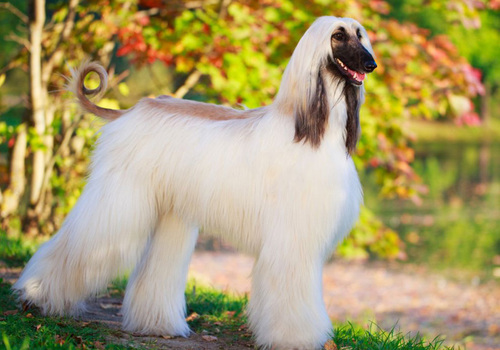Properly grooming an Afghan Hound requires a great deal of time and effort. Groomingis an essential part of living with an Afghan. Plan to brush and comb the Afghan Hound’s thick, silky hair three times a week to prevent or remove mats and tangles, and bathe him as needed. You may want to invest in a professional dog blow dryer if you bathe him frequently.
The Afghan sheds moderately. The more often you brush him, the less hair you will have to fall off the dog and onto your floors, furniture and clothing. Afghan Hounds have pendant ears, meaning their ears hang, which can lead to ear infections. Regular, weekly ear cleanings with a cotton ball and a veterinarian-recommended cleanser can keep infections at bay.
Because Afghans are sighthounds, bred to hunt and chase prey by sight, they will have a strong instinct to run off in pursuit of perceived prey; walking off leash is not advisable.
Short walks do not provide enough exercise for this athletic breed, and some owners take their leashed Afghans on long runs once they reach maturity.
Ideally, an Afghan should have the opportunity to run full out several times a week in a large, enclosed area. Afghans are tall, lean, and strong, which makes them excellent jumpers, so their exercise area must have a high, secure fence.
TheAfghan Hound should do well on high-quality dog food. Any diet should be appropriate to the dog's age (puppy, adult, or senior).
Adult Afghans should eat about two to two and a half cups of dry food a day divided into two meals, though dry food can be supplemented in part or entirely by wet food. Afghan puppies, seniors, and those experiencing injury or illness have different nutrition needs, so it's important to get clear directions from a qualified vet when determining their diet.
Learn about whichhuman foodsare safe for dogs, and which are not. Check with your vet if you have any concerns about your dog’s weight or diet.Clean, fresh water should be available at all times.
Sighthounds such as Afghans have naturally low stores of body fat, so they tend to be sensitive to anesthesia; breed experts recommend seeking out a sighthound-savvy veterinarian for surgical procedures. Like other deep-chested types of dogs, Afghan Hounds can experiencebloat, a sudden and life-threatening swelling of the abdomen, and owners should educate themselves about its symptoms and what to do should bloat occur.
These dogs respond best to calm training. They can seem distant and aloof at times, which helps create that famous “aristocratic” air, but if you are able to demonstrate effective leadership there’s no reason the Afghan Hound can’t be perfectly obedient and eager-to-please dog. Just be sure not to treat it too harshly, as it can be a little sensitive to overtraining and prefers a patient leader.












